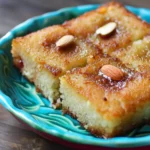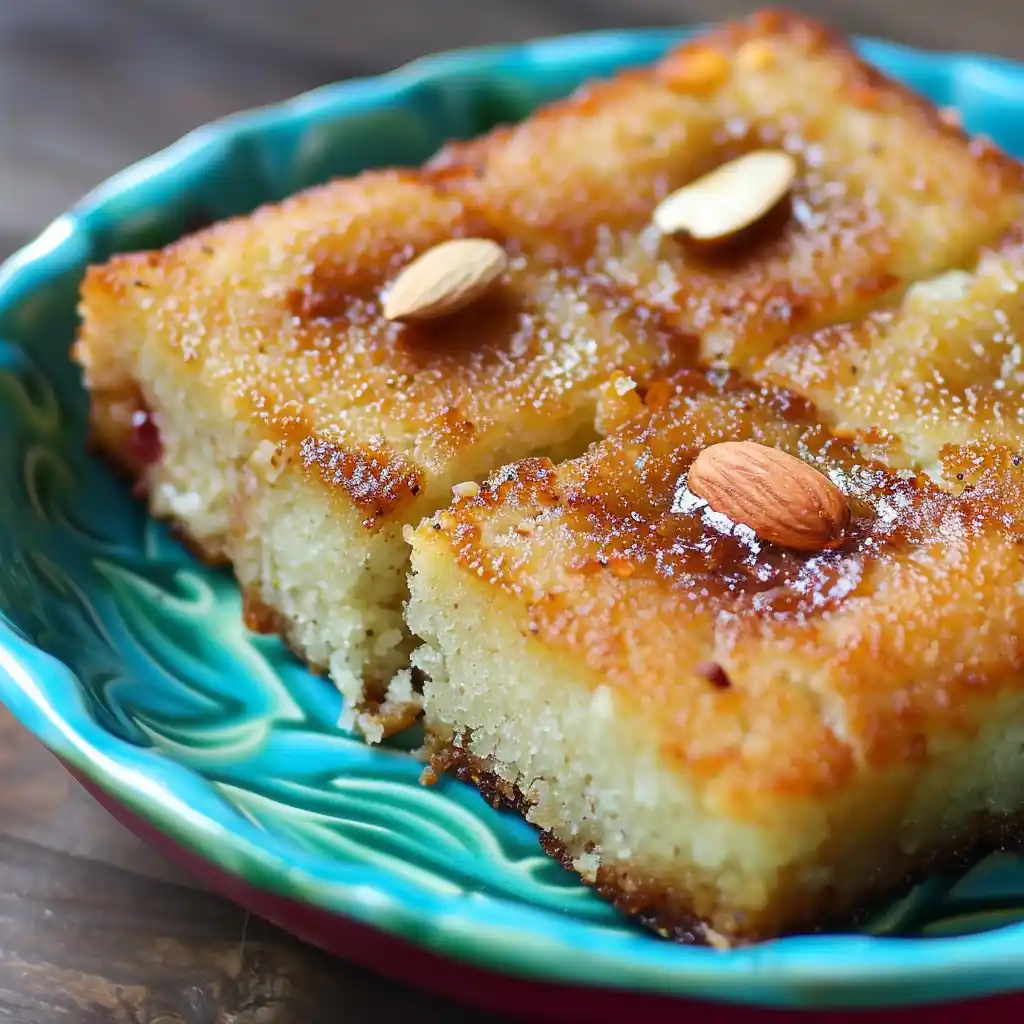Basbousa is a traditional Middle Eastern sweet cake that’s soaked in a fragrant syrup, creating a moist and delectable treat. This coconut yogurt semolina cake originated in Egypt but has become beloved throughout the Mediterranean and Middle East. Its distinctive texture—slightly grainy yet incredibly moist—combined with the aromatic syrup makes it an irresistible dessert for special occasions or alongside a cup of tea.
Why You’ll Love This Recipe
- Simple ingredients that transform into an exotic, impressive dessert
- The perfect balance of sweetness with a unique texture unlike standard flour cakes
- Can be prepared in advance and actually tastes better the next day
- Versatile recipe that welcomes various nuts and flavor adaptations
- Impressive presentation with minimal effort, making it perfect for entertaining
Ingredients
- Semolina: Use coarse semolina for authentic texture, though cream of wheat can work as a substitute if needed. This forms the foundation of the cake’s unique grainy texture.
- Coconut: Sweetened or unsweetened shredded coconut both work well, adding wonderful texture and tropical flavor to the cake.
- Butter: Use unsalted butter for best results, melted to incorporate easily into the dry ingredients. The butter adds richness and helps achieve that beautiful golden color.
- Sugar: Regular granulated sugar works perfectly in both the cake and syrup. The amount can be adjusted slightly based on your sweetness preference.
- Baking Soda: This leavening agent helps the cake rise slightly while maintaining its dense, satisfying texture.
- Yogurt: Plain yogurt adds moisture and a subtle tang that balances the sweetness. Sour cream makes an excellent substitute for an even richer result.
- Nuts: Whole roasted or blanched almonds are traditional, but pistachios or cashews offer delicious alternatives. For nut-free options, maraschino cherries make a beautiful garnish.
- Syrup Ingredients: Sugar, water, optional rosewater (not rose extract), and lemon juice create the signature sweet soaking syrup that makes basbousa so special.
Variations
Citrus Basbousa
Add the zest of one orange or lemon to the batter and a tablespoon of the corresponding juice to the syrup. This bright variation offers a refreshing twist on the traditional recipe, perfect for summer entertaining.
Honey Basbousa
Replace half the sugar in the syrup with good quality honey and add a pinch of cinnamon. This variation provides a more complex sweetness and a subtle warmth that pairs beautifully with the semolina base.
Coconut-Free Version
For those who don’t enjoy coconut, simply omit it and increase the semolina by 1/3 cup. Add a teaspoon of vanilla extract to the batter for additional flavor. The result is a more traditional semolina cake that still maintains the wonderful texture basbousa is known for.
How to Make the Recipe
Step 1: Prepare the Baking Dish
Begin by preheating your oven to 400°F (200°C). Thoroughly grease an 8×8 or 9×9 square baking pan or a 9-inch round pie dish with butter or olive oil. The generous greasing ensures the cake won’t stick after baking and helps create a beautiful golden crust.
Step 2: Mix the Batter
In a large mixing bowl, combine the semolina, coconut, sugar, and baking soda. Add the melted butter and use your hands to thoroughly incorporate it into the dry ingredients. The mixture should have a crumbly texture at this stage. Next, add the yogurt and continue mixing with your hands until you achieve a thick, cohesive batter. Unlike typical cake batters, this mixture should be thick enough to press firmly into the pan, not pourable.
Step 3: Shape and Pre-Cut
Transfer the batter to your prepared baking dish and use your hands to press it firmly and evenly into the pan. The cake should be approximately 1 inch thick. Using a butter knife, score the surface in a diamond or square pattern, cutting about halfway through the batter. This traditional pre-cutting helps the syrup penetrate evenly later. Place a nut (almond, pistachio, or cashew) or a maraschino cherry in the center of each diamond or square for decoration.
Step 4: Bake and Prepare Syrup
Bake the cake in the preheated oven for 30-40 minutes until it achieves a beautiful bronze color. While the cake bakes, prepare the syrup by combining sugar, water, optional rosewater, and lemon juice in a saucepan. Bring to a boil over high heat, then reduce and simmer for about 10 minutes until the mixture slightly thickens and coats the back of a spoon. Allow the syrup to cool completely.
Step 5: Soak and Serve
When the cake is done, if the top isn’t golden brown, you can briefly broil it for 1-2 minutes to achieve the desired color (watch carefully to prevent burning). While the cake is still hot, cut along the pre-scored lines again, then immediately pour the cold syrup evenly over the hot cake. Let the cake rest for at least 30 minutes to absorb the syrup before serving.
Tips for Making the Recipe
- Use your hands for mixing the batter—this gives you better control and helps you feel when the texture is just right
- Don’t skip the pre-cutting step before baking; it’s essential for proper syrup absorption and traditional presentation
- Make sure the syrup is completely cool before pouring it over the hot cake—this temperature difference is key for proper absorption
- For the most authentic flavor, try to find rosewater (not rose extract) at Middle Eastern markets or specialty stores
- Allow the basbousa to rest for at least 4 hours (or overnight) for the best flavor and texture as it continues to absorb the syrup
- For a more defined cut, dip your knife in hot water between slices when serving
How to Serve
Basbousa is traditionally served at room temperature, cut into diamond or square shapes. It pairs beautifully with strong coffee, mint tea, or Turkish coffee to balance its sweetness. For an extra indulgent presentation, serve with a small dollop of whipped cream or a scoop of vanilla ice cream on the side. Fresh berries or a light dusting of ground pistachios can add a beautiful color contrast and complementary flavor. For authentic Middle Eastern hospitality, serve on small decorative plates alongside tiny cups of cardamom-spiced coffee.
Make Ahead
Basbousa is actually better when made ahead, making it perfect for entertaining. You can prepare the entire cake up to 3 days in advance and store it covered at room temperature. The flavors will continue to develop and the texture will become even more moist and delicious over time.
For longer storage, you can freeze the baked (but not syrup-soaked) cake for up to 3 months. Thaw completely at room temperature, then warm slightly in a 300°F oven for 10 minutes before adding freshly made cooled syrup.
You can also prepare the syrup up to a week in advance and store it in the refrigerator in an airtight container. Simply bring it to room temperature before pouring over the hot cake.
FAQs
Can I use fine semolina instead of coarse?
Yes, you can use fine semolina, but the texture will be slightly different—less grainy and more cake-like. If using fine semolina, reduce the amount of yogurt slightly as fine semolina absorbs less moisture.
Why did my basbousa turn out dry?
The most common reason for dry basbousa is not using enough syrup or not allowing enough time for the syrup to be absorbed. Make sure to pour all the syrup over the hot cake and allow it to rest for at least 30 minutes before serving. Also, be careful not to overbake the cake, as this can make it too dry to properly absorb the syrup.
Can I make this recipe dairy-free?
Yes! You can substitute the butter with coconut oil and use coconut yogurt instead of dairy yogurt. These substitutions maintain the moisture and richness while making the dessert suitable for those avoiding dairy.
How do I know when the syrup is ready?
The syrup is ready when it has thickened slightly and coats the back of a spoon. If you run your finger through the syrup on the back of the spoon, it should leave a clear path that doesn’t immediately fill in. Be careful not to reduce it too much, or it will become too thick and sticky when cooled.
Conclusion
Basbousa is a delightful introduction to Middle Eastern desserts that combines simple ingredients to create something truly special. The contrast between the semolina’s gentle graininess, the aromatic syrup, and the crunch of nuts creates a textural experience unlike any other cake. Whether you’re hosting guests or simply treating yourself to something sweet, this coconut yogurt semolina cake offers a taste of tradition that transcends borders. Try making it this weekend and discover why this ancient recipe has stood the test of time!
Print
Basbousa (Coconut Yogurt Semolina Cake)
- Total Time: 55 minutes (plus cooling time)
- Yield: 16 servings 1x
- Diet: Vegetarian
Description
A rich, sweet Middle Eastern cake made with semolina and coconut, soaked in a fragrant syrup for a moist, decadent dessert. This traditional treat features a distinctive texture and is topped with crunchy nuts for the perfect finish.
Ingredients
- 2 cups coarse semolina (or cream of wheat)
- 1 cup coconut
- 1/2 cup butter, melted (1 stick)
- 1⁄3 cup sugar
- 1 teaspoon baking soda
- 1 cup plain yogurt or sour cream
- 1⁄3 cup whole roasted or blanched almonds (or pistachios, cashews, or maraschino cherries)
- For The Syrup
- 2 cups sugar
- 1 1/2 cup water
- 1 tablespoon rosewater (optional)
- 1 teaspoon lemon juice
Instructions
- Prepare the Baking Dish
- Pre-heat oven to 400°F (200°C). Thoroughly grease an 8×8 or 9×9 square pan or a 9-inch round pie dish with butter or olive oil. The greasing is important to prevent sticking as this is a syrup-soaked cake.
- Mix the Batter
- In a large bowl, combine the semolina, coconut, sugar, baking soda, and melted butter. Use your hands to thoroughly incorporate the butter with the dry ingredients until well mixed. Add the yogurt and continue mixing with your hands until the mixture is fully combined. The batter should be thick and easy to press with hands, not runny like typical cake batter.
- Form and Score the Cake
- Press the mixture firmly into your prepared baking dish, creating an even layer about 1 inch thick. Using a butter knife, score the surface in a diamond or square pattern. Place one almond (or your choice of nut/cherry) onto each pre-cut section to decorate and mark the cutting lines.
- Bake the Cake
- Bake at 400°F for 30-40 minutes until the cake develops a bronze-brown color on top. If the top doesn’t brown sufficiently, turn on the broiler for 1-2 minutes to achieve a golden/bronze color, watching carefully to prevent burning.
- Prepare the Syrup
- While the cake is baking, make the syrup by combining sugar, water, rosewater (if using), and lemon juice in a saucepan. Bring to a boil over high heat, then reduce and simmer for about 10 minutes or until the syrup thickens enough to coat the back of a spoon.
- Finish and Serve
- When the cake is done, remove from the oven and immediately re-cut along the pre-scored lines. While the cake is still hot, pour the cold syrup evenly over the top, allowing it to soak in. Let the cake cool completely before serving to allow the syrup to be fully absorbed.
Notes
- Basbousa originates from Egypt but is popular throughout the Middle East and North Africa, with regional variations. For best results, use coarse semolina rather than fine for the authentic grainy texture. The cake can be stored at room temperature for up to 3 days or refrigerated for up to a week. Some variations include adding vanilla, cinnamon, or orange blossom water to the batter or syrup.
- Prep Time: 15 minutes
- Cook Time: 40 minutes
- Category: Desserts
- Method: Baking
- Cuisine: Middle Eastern
Nutrition
- Serving Size: 1 piece
- Calories: 245
- Sugar: 26g
- Sodium: 85mg
- Fat: 9g
- Saturated Fat: 6g
- Unsaturated Fat: 3g
- Trans Fat: 0g
- Carbohydrates: 38g
- Fiber: 2g
- Protein: 3g
- Cholesterol: 15mg


